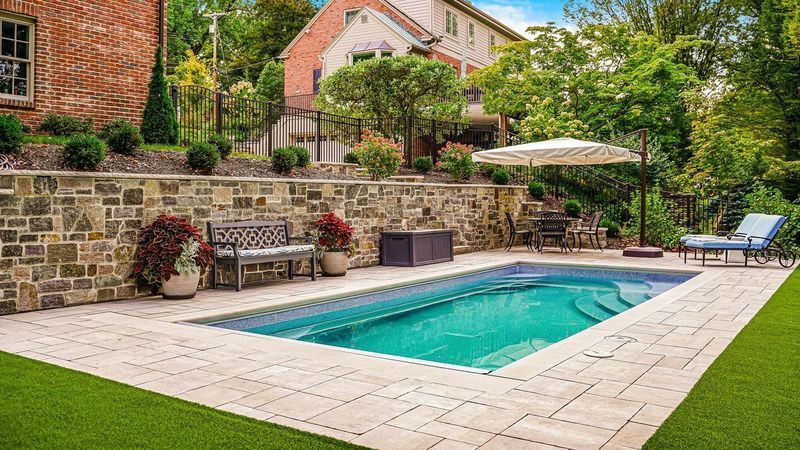Fiberglass vs. Concrete Pools - Which Is Right for Your Home?

Dreaming of a relaxing backyard where cool off during hot summer days or host unforgettable pool parties? Choosing the suitable material for your in-ground pool is one of the most critical decisions you'll face as a homeowner.
Many find themselves facing the battle between fiberglass and concrete pools, each offering distinct advantages and some drawbacks.
Choosing between fiberglass and concrete pools is not just about aesthetics; it impacts installation times, maintenance needs, and overall costs. This comprehensive pool guide will walk you through the construction, durability, maintenance, and customization options of both types.
Overview of Fiberglass Pools
Construction and Installation
Fiberglass pools are pre-manufactured shells made from reinforced fiberglass and gel coat. Once the mold is ready, a seamless piece is transported to your home and installed into an excavated hole. Because the pool is prefabricated, installation is generally quick, often taking just one to three weeks. This faster setup allows homeowners to enjoy their new pool sooner than other types.
Durability and Maintenance
Fiberglass pools are known for their resilience. The gel coat surface is smooth, non-porous, and resistant to algae, making the pool easier to clean and maintain. They are less prone to cracking than concrete pools, partly due to the material's flexibility, allowing it to adapt to ground movement. With proper care and regular maintenance, a fiberglass pool can last up to 25 years or more, making it a long-lasting investment.
Design and Customization
While fiberglass pools come in a variety of shapes and sizes, they are limited by the molds available from manufacturers. Homeowners may find fewer options compared to the extensive possibilities with concrete pools. However, advancements in design have made it possible to incorporate features such as built-in steps, benches, and tanning ledges. Although less customizable, manufacturers offer a fair variety of designs that can fit most backyard layouts.
Overview of Concrete Pools
Construction and Installation
Concrete pools, gunite or shotcrete pools, are constructed on-site. This process involves spraying a cement, sand, and water mixture onto a steel-reinforced framework, which is then shaped and smoothed into the desired form. Due to the labor-intensive nature of this method, installation typically takes longer, often spanning three to six months. However, the result is a highly durable and customizable pool.
Durability and Maintenance
Concrete pools are incredibly robust and can last for decades with proper care. The material can withstand major wear and tear, making it ideal for those who plan to use their pool frequently. However, the porous nature of concrete makes it more susceptible to algae growth, requiring more regular maintenance. Resurfacing a concrete pool every 10 to 15 years is often necessary to maintain its appearance and structural integrity.
Design and Customization
One of the main features of concrete pools is their limitless customization options. From freeform designs to intricate shapes, the flexibility in design allows homeowners to create unique and personalized poolscapes. Features like waterfalls, grottos, and custom tanning ledges can be easily incorporated. This level of customization makes concrete pools an attractive option for those with specific aesthetic and functional preferences.
Comparison of Fiberglass and Concrete Pools
Installation Time
The installation timeline is one of the most significant differences between fiberglass and concrete pools. Fiberglass pools have a clear advantage in this area, with installation often completed within a few weeks. In contrast, concrete pools require several months due to the complex construction process. Fiberglass may be the preferred choice for homeowners eager to take a dip as soon as possible.
Maintenance and Longevity
When it comes to pool maintenance, fiberglass pools typically require less effort and fewer chemicals, thanks to their smooth, non-porous surface. This makes them more cost-effective in the long run. On the other hand, concrete pools demand more intensive upkeep to prevent algae growth and maintain water chemistry. Both types offer impressive longevity, but fiberglass may edge out slightly with less frequent resurfacing needs.
Customization Options
Customization is where concrete pools shine. The ability to mold the pool into any shape and include various features makes it ideal for those with specific design visions. Fiberglass pools, while offering a decent range of designs, cannot match the extensive customization options of concrete. Homeowners should weigh their desire for a unique poolscape against the practical benefits of faster installation and simpler maintenance.
Making Your Decision
Evaluating Your Needs
Choosing the suitable pool material depends on your specific needs and preferences. Consider factors such as how quickly you want the pool installed, your willingness to commit to regular maintenance, and your budget. Fiberglass pools offer a quicker, low-maintenance solution, while concrete pools provide unparalleled design flexibility but require more upkeep.
Consulting with Professionals
Discussing your options with pool professionals can provide invaluable insights tailored to your situation. Companies like Paladina Pools specialize in helping homeowners make informed decisions by evaluating their needs and preferences. Our expertise can guide you towards the best choice, ensuring your pool investment brings joy for many years.
Create Your Dream Pool with Paladina Pools Today!
Both fiberglass and concrete pools have their unique advantages and challenges. Fiberglass pools are praised for their quick installation and low maintenance, while concrete pools are celebrated for their customization potential and durability.
By carefully considering your pool needs and consulting with experienced professionals, you can select the pool that best enhances your backyard oasis. For personalized advice and to discuss your options further, contact Paladina Pools and schedule an appointment today!

Author: Matt Paladina
Matt Paladina, founder of Paladina Landscape Design Build and Paladina Pools, began his journey in 2006 with a small pickup truck and a big vision. Over the years, he has grown his business from basic lawn care to creating custom outdoor living spaces and pools, earning a reputation for innovative design and exceptional craftsmanship.